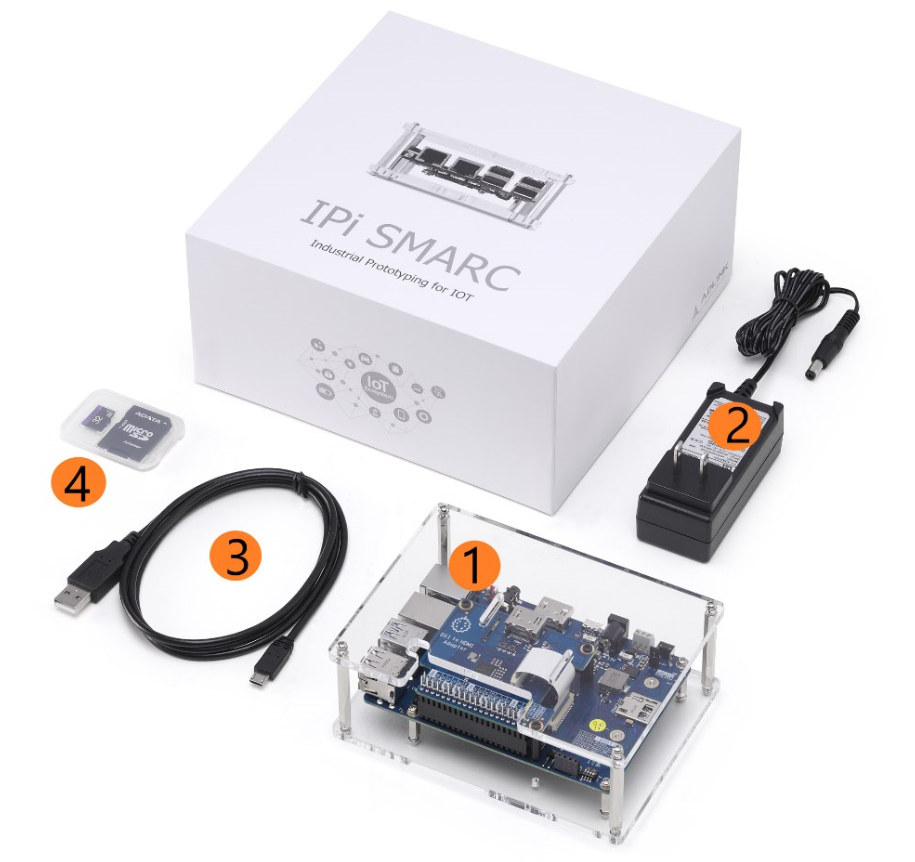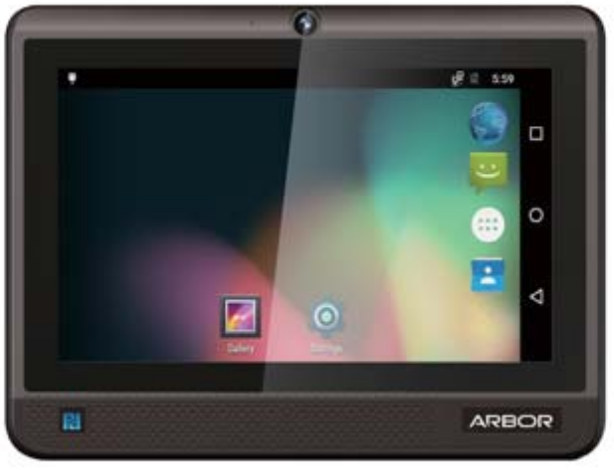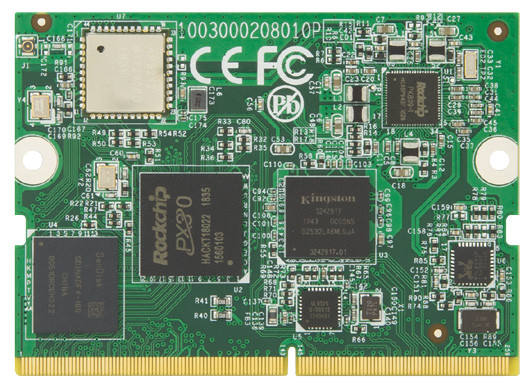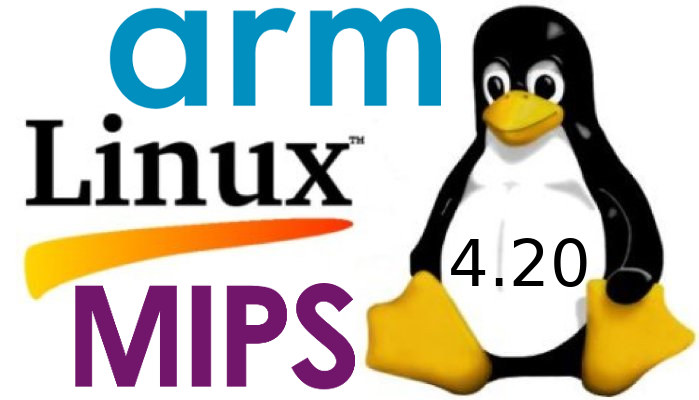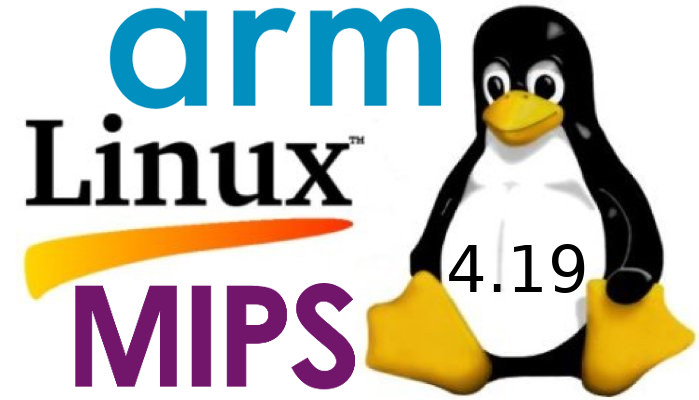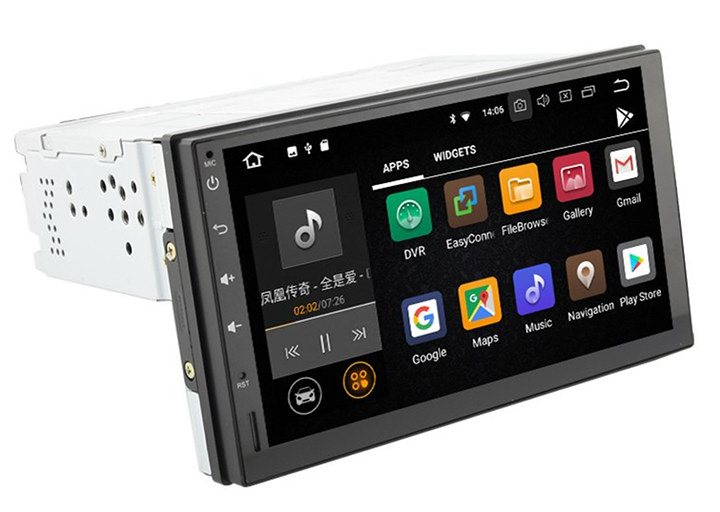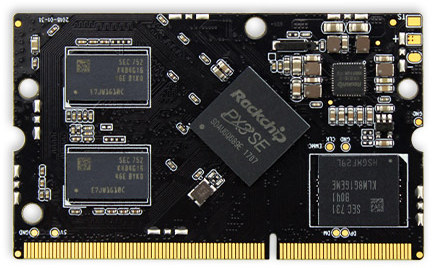ADLINK Technology has just announced the Industrial-Pi (I-Pi) SMARC Development Kit to help engineers quickly design prototypes for industrial applications using peripherals and sensors. The I-Pi SMARC development kit is comprised of a baseboard, LEC-PX30 SMARC-compliant Rockchip PX30 system-on-module, an acrylic case, a 12V/2A power supply, USB cable, and a 32GB MicroSD card. The company promotes the kit as “an industrial-ready substitute for Arduino and Raspberry Pi (RPi) platforms that are commonly used for prototyping but cannot typically be ‘dropped’ into an industrial solution as-is“. LEC-PX30 SMARC System-on-Module Specifications: SoC – Rockchip PX30 Quad-core Arm Cortex-A35 CPU with TrustZone technology, ARMv8 Cryptography Extensions, Mali-G31 GPU System Memory – 1GB or 2GB DDR3L at 1066/1333 MHz Storage – 8, 16, 32 or 64 GB eMMC flash Connectivity – 10/100M Ethernet from SoC, 10/100M Ethernet via LAN9514 USB 2.0 Ethernet controller Video Decoding – H.264 up to 1080p60, H.265/HEVC up to 1080p60, […]
Arbor M1016 10.1″ Medical-Grade Tablet Targets Infotainment & Kiosk Applications
Arbor M1016 Healthcare & Kiosk Tablet Arbor offers various products in the embedded systems field, automotive IoT and healthcare infotainment, as well as patient interfaces for hospitals. The M1016, a 10.1″ Healthcare Infotainment Terminal is a soon to be released alternative to the company’s HTab. Previous Articles for Arbor HTab healthcare bedside patient entertainment tablet and the IoT-800N Automotive Panel PC have both been reported on in previous articles about Arbor market entrants. The Basics and Kiosk Design The M1016 runs an Arm Cortex-A35 CPU @ 1.5GHz, that supports Android 8.1, and offers a variety of features for many of the different capabilities of patients under care. The design is based on a Kiosk model, with an a-la-carte menu arrangement. Access and Power Consumption The unit itself is fanless with low power requirements that lend themselves well to thin enclosure design and ease of use. The GPU is a Mali-G31 […]
ARBOR IoT-800N Android/Ubuntu Panel PC Targets Automotive Applications, Industrial Automation
Rockchip PX30 is a low cost low power quad core Arm Cortex-A35 processor mostly designed for car infotainment systems. Last month, we also found the processor in ARBOR SOM-RP301 system-on-module designed for retails kiosks such as automated currency exchange machines, electronic restaurant menus, , ticketing kiosks, etc… ARBOR has now launched another Rockchip PX30 platform with their IoT-800N 8″ Panel PC running Android 8.1 or Ubuntu 16.04, and designed for automotive applications such as fleet management or driver fatigue monitoring thanks to interfaces like OBD-II, as well as industrial automation. ARBOR IoT-800N specifications: SoC – Rockchip PX30 Quad-core Arm Cortex-A35 processor System Memory – 2GB DDR4 memory soldered on board Storage – 16GB eMMC flash soldered on board, microSDHC/microSDXC/microSD card socket up to 128GB Display – 8” TFT LCD display with 1024 x 600 resolution, 5-point projected capacitive touchscreen Camera – 8MP front-facing MIPI CSI camera with auto-focus Audio – […]
ARBOR Introduces SOM-RP301 Rockchip PX30 SoM for Retail Kiosks
Rockchip PX30 is a quad core Cortex-A35 processor with a dual VOP (Video Output Processor) in order to drive two independent displays, that has low power consumption, low thermal requirements, and that we previously found in some car infotainment systems. But the processor is also suitable for other applications, and ARBOR Technology recently launched SOM-RP301 system-on-module based on the PX30 processor, and specifically designed for fanless retail kiosks such as electronic restaurant menus, automated currency exchange machines, ticketing kiosks and more. SOM-RP301 system-on-module specifications: SoC – Rockchip PX30 quad core Cortex-A35 processor @ 1.5 GHz with Arm Mali-G31 MP2 GPU System Memory – 1GB LPDDR3 (Up to 4GB as option) Storage – 16 GB eMMC flash Connectivity – Fast Ethernet transceiver, 802.11 b/g/n/ac WiFi 5 + Bluetooth 4.0 module Edge Connector – SO-DIMM connector with Display – LVDS or MIPI DSI Camera – MIPI CSI RX interface with 8MP ISP […]
Linux 4.20 Release – Main Changes, Arm and MIPS Architectures
After Greg K-H handling Linux 4.19 release, Linus Torvalds is back at the helm, and released Linux 4.20 just before Christmas: Let’s face it, last week wasn’t quite as quiet as I would have hoped for, but there really doesn’t seem to be any point to delay 4.20 because everybody is already taking a break. And it’s not like there are any known issues, it’s just that the shortlog below is a bit longer than I would have wished for. Nothing screams “oh, that’s scary”, though. And as part of the “everybody is already taking a break”, I can happily report that I already have quite a few early pull requests in my inbox. I encouraged people to get it over and done with, so that people can just relax over the year-end holidays. In fact, I probably won’t start pulling for a couple of days, but otherwise let’s just […]
Linux 4.19 Release – Main Changes, Arm and MIPS Architectures
With Linus Torvalds taking a leave from the Linux kernel project, Greg Kroah-Hartman was the one to release Linux 4.19 last Sunday: Hi everyone! It’s been a long strange journey for this kernel release… While it was not the largest kernel release every by number of commits, it was larger than the last 3 releases, which is a non-trivial thing to do. After the original -rc1 bumps, things settled down on the code side and it looks like stuff came nicely together to make a solid kernel for everyone to use for a while. And given that this is going to be one of the “Long Term” kernels I end up maintaining for a few years, that’s good news for everyone. A small trickle of good bugfixes came in this week, showing that waiting an extra week was a wise choice. However odds are that linux-next is just bursting so […]
Rockchip PX30 Processor Powers Android 8.1 Car Infotainment Systems
Rockchip RK3326 and RK3308 are the first Arm Cortex A35 processors from the company, and are designed for smart AI solutions such as smart speakers and smart displays. It turns out RK3326 processor has a sibling called Rockchip PX30 with most of the same features, but with dual VOP (Video Output Processor) support to handle up to two independent displays, as well as an Ethernet MAC and a USB host block. Rockchip RK30 key features and specifications: CPU – Quad-core Arm Cortex-A35 GPU – Mali-G31 MP2 GPU Memory I/F – DDR4/DDR3/DDR3L/LPDDR3/LPDDR2 Storage I/F – MLC NAND, eMMC 4.51, Serial Nor FLASH Video 1080p H.265/H.264/VC-1/MPEG/VP8 video decoder 1080p H.264/VP8 video encoder Display Interfaces – MIPI-DSI/LVDS/RGB interface, dual VOP Audio I/F – 1x8ch I2S/TDM, 1x8ch PDM, 2x2ch I2S Camera I/F – MIPI CSI and DVP; built-in 8MP ISP Networking – 10/100M Ethernet Other Peripherals – SDIO3.0, USB2.0 HOST & OTG, 4x I2C, […]
Firefly Core-PX3-SEJ SoM Features Rockchip PX3-SE Industrial-Grade Processor
Allwinner is not the only Chinese fabless silicon vendor to offer industrial grade processors, as Rockchip PX3 SE quad core Cortex A7 processor can also operate in the industrial temperature range (-20°C to 80°C). I had covered Rockchip PX3 previously, but it’s the first time I read about Rockchip PX3-SE processor, and Firefly is the first company to integrate the processor into a product, namely Core-PX3-SEJ system-on-module. Core-PX3-SEJ module specifications: SoC – Rockchip PX3-SE quad core Cortex A7 processor @ 1.3 GHz with Arm Mali-400MP2 GPU – See datasheet for details System Memory – 512MB, 1GB or 2GB dual-channel DDR3 Storage – 4GB, 8GB, 16GB, or 32GB eMMC flash Edge Connector – 204-pin DDR3 SO-DIMM connector with Storage – Micro SD card interface Connectivity SDIO interface for WiFi & Bluetooth module Gigabit Ethernet Display – HDMI up to 1080p, CVBS, MIPI DSI or LVDS for LCD display Audio – Via […]


